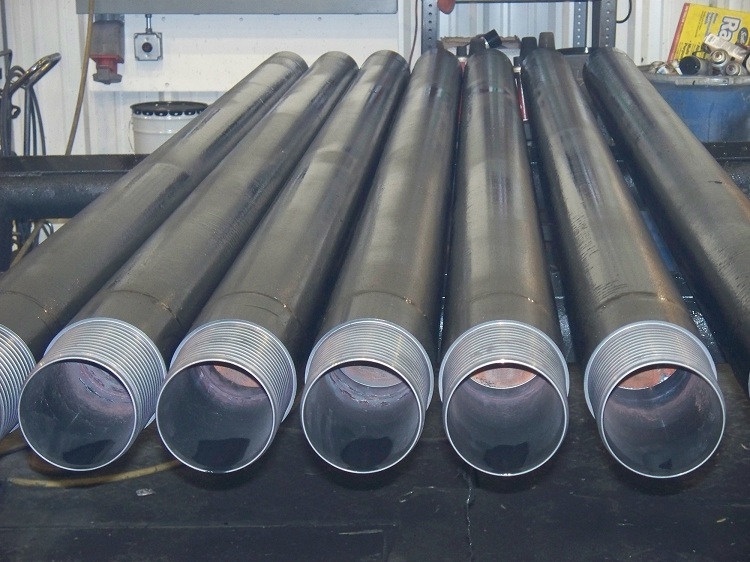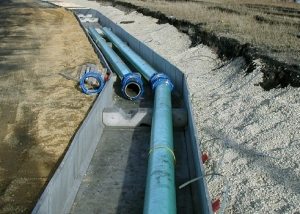A well pipe is an important component of an autonomous water supply system that protects water from external pollution. Which pipe to choose for the well? The decision is made depending on several conditions, primarily on the purpose of the well, the quality of the water that is supposed to be produced, and also taking into account the depth of the aquifer and the amount intended to equip the water source.
Content
Which pipe is best to use for a well
Having made a decision on the creation of an autonomous water supply system, one will have to face a difficult choice: which pipe is better to use for arranging a well? The choice of casing is determined by several circumstances:
- soil structure;
- well diameter;
- drilling depth;
- the location of the aquifer;
- selected drilling technology;
- the possibility of penetration of wastewater and surface water (top water);
- level of overlying aquifers.
The choice is relatively small, the designs are made of the following materials:
- asbestos cement;
- metal;
- polymers.
Choosing a casing to protect the well from depressurization, i.e., water from the upper layers, which differs, as usual, is not the best quality, and penetration of sand and other polluting rocks from the outside, you should take care:
- about the strength and durability of operation, the reliability of the barrier on the path of collapse of the walls of the well;
- that the selected material does not affect, in contact with water, a change in its chemical composition and a decrease in quality.

The choice of tube for casing the well depends on the type of soil, the depth of water and other factors
Deciding which pipe is best for the well should be based on specific conditions, and not guided solely by general considerations.
The advantages of using asbestos cement
Asbestos cement products gradually go out of fashion. The reasons why they are gradually being squeezed out of the market can be reduced to four main ones:
- Fragility and tendency to delamination.
- They do not provide sand resistance; therefore, their use in the presence of sandy impurities in water is desirable to exclude.
- Pretty significant weight.
- Distrust of asbestos as a material with an impeccable environmental reputation. Although the threat comes only from dust exclusively amphibole asbestos.
Note! The use of chrysotile cement products for water supply is recognized as absolutely safe for health.
The advantages of choosing an asbestos-cement pipe for the construction of a well bear many. These include:
- low cost;
- rot-proof and corrosion resistant. No special protection against groundwater is required;
- strength;
- low thermal conductivity, which allows you to abandon insulation;
- non-susceptibility to temperature extremes, frost resistance;
- small, in comparison with metal structures, weight;
- durability of operation.
Asbestos cement products during installation can only be connected with couplings, while each link is attached as firmly as possible. Even having doubts about the environmental safety of asbestos cement, it is quite acceptable that it is used for irrigation and land reclamation. As the best option, asbestos cement is used when drilling in limestone soils.
Using a metal pipe for a water well
It is extremely prestigious to use copper pipes for an artesian well. To plant a pipe in this way will be very expensive, but it is incredibly good in terms of environmental safety and improving the taste of drinking water.
Among metal products, when a well is equipped, steel is usually chosen. Their disadvantages:
- heavy weight;
- high price;
- susceptibility to corrosion, resulting in the taste of water deteriorating by rust.
These circumstances significantly influenced the choice in favor of the use of steel products when it is necessary to build a well. Nevertheless, steel is still used when it is not possible to use other materials, for example, on moving soils. For artesian wells, it is advisable to use a seamless (seamless) pipe. It costs more than welded (suture), but it will last much longer.
Steel pipelines are connected using two types of connection:
1. Threaded. High-quality taper threads can be applied to a pipe with a wall thickness of at least six millimeters. Cheaper the construction using products with a smaller wall thickness, provoke damage to the seams in the electric-welded elements.
Reuse of electric welded products with a wall thickness of 4.5 mm with a threaded connection is not possible. They have to be sent for re-cutting or replaced, or continue to use the defective column.
2. Welded. The use of electric welding increases the cost of well construction. Therefore, often there is a desire to use a more economical threaded connection. It is widely believed that welding seams are unreliable. However, practice shows that destruction occurs outside the weld zone, since the suture joint is stronger than the rest of the metal surface. Moreover, the use of a special electrode coating for welding alloys the seam, increasing its strength and resistance to corrosion.
Drilling specialists suggest using galvanized pipe of conversion origin as a casing. Such products were made for field trunk collapsible pipelines. The nominal diameter of the pipe is 150 mm, the working pressure is 6 MPa. These defense products were not previously used, as they were intended for the state reserve. Although the wall thickness is relatively small (3.2 mm), galvanization has a positive effect on the duration of operation. Mounting six-meter galvanized products is very convenient, since they are initially equipped with welded sockets with a thickness of 10 mm.
Installation of steel products is recommended on limestone and sandy soils. To prevent rust from entering drinking water, it is advisable to install an additional cleaning filter.
How to casing a well with a plastic pipe
When creating an autonomous water supply, it is possible to use three types of polymer pipes:
- PVC (made from unplasticized polyvinyl chloride);
- HDPE (low pressure polyethylene is used);
- PP (polypropylene).
Important! Plastic constructions, as a general rule, are not used at depths exceeding fifty meters.
Without going into details, they note the general advantages of using plastic pipeline structures:
- low cost;
- light weight;
- durability of operation;
- ease of installation;
- tightness;
- resistance to corrosion and exposure to aggressive chemicals in the soil.
Polymer products can be used for casing both as an independent element and in combination with a steel structure. A well cased with a plastic pipe is mounted similarly to the others. As the casing is lowered into the drilled zone, next elements are connected to it with a threaded connection. To achieve greater reliability of the connection, it is additionally sealed, for which special rubber seals are installed. This procedure is repeated until complete casing of the well is completed. The lower edge is not brought to the bottom by about half a meter to ensure free flow of water regardless of the time of year.

Polymer pipes are prepared before connection - the chamfer is removed on the socket, if necessary, seals are installed
Important! In order to avoid structural damage during casing descent, it is necessary to achieve perfect evenness of the source barrel.
It is allowed to use sewer pipes for a well. Naturally, not if the water is intended solely for drinking. A source built for industrial water, for irrigation and land reclamation, may well be equipped in this way. This is in no way a violation of sanitary standards. And sewerage with the equipment of autonomous water supply should be provided for. Responsibly approach the placement of sewage to avoid water pollution.
A well can be constructed without casing pipe. True, the existence of such water supply facilities seems mythical to many experts. Collapse of the walls of the source will disable it as soon as possible. And restoration will require a lot of money, time and effort.
Calculation of the diameter of the production pipe for a well for water
The pipe diameter is selected taking into account the following circumstances:
- features of the site where the well is installed;
- the goals of its construction;
- submersible pump parameters.
For domestic needs, as usual, submersible pumps of three and four inch diameter are used. The diameter is calculated in the following way: 4 mm of the gap and 15 mm of the thickness of the polymer pipe wall are added to the diameter of the power equipment (74 mm or 100 mm). Based on these data, products with suitable parameters are selected. As a rule, the drilling of a sufficiently complex hydraulic structure, such as a well, takes place in difficult hydrogeological conditions. Often, the use of multiple casing strings with different diameters is required. Therefore, when constructing a well, it is quite possible to make adjustments to the structure during the course of its construction.

An important parameter when choosing pipes is their diameter, on which, in turn, the selection of the pump
In most cases, in order to reduce construction costs, they initially focus on a smaller diameter of the casing pipe. This affects the final diameter of the well, which suggests the possibility of using only a three-inch submersible domestic pump. And the difference in the cost of three-inch and four-inch power equipment is very significant, although the operational characteristics are almost identical.
Features of the dismantling of the well in-house
Any construction from time to time requires repairs. Perhaps the well needs to replace some structural elements, or the abandoned hydraulic structure needed to be restored.Professional drillers dismantle and repair a well in a quality and fast manner. They have experience, dexterity and the necessary equipment, such as tubes, taps and overshots.
Having the time and opportunities to dismantle a well, it’s completely possible and independent. To do this, you will need:
- powerful jack;
- two L-shaped racks to be installed upside down. Racks of meter height and a width of up to sixty centimeters are made from channel number 10;
- bearing with an inner diameter of 40 mm. Fastens to the top of the inverted L-shaped rack;
- drum. Its axis is threaded through the bearing;
- cable;
- crimp clamp.
The pipe extraction sequence is as follows:
- Its end is fixed by means of a crimp clamp and a loop. The cable is fixed.
- On a short shoulder of the lever (jack) the clamp is fixed.
- Gradual rotation of the handle of the drum pulled out the structure.
Important! When removing a long pipe, it is recommended to use a special stocking that holds it when intercepting the cable attachment.
Arrangement of an autonomous water supply system requires the correct selection of pipes. Properly performing the calculations, it will be possible not only to successfully install the well, but also to provide opportunities for its flawless operation for a long period and the prompt completion, if necessary, of repair work.









